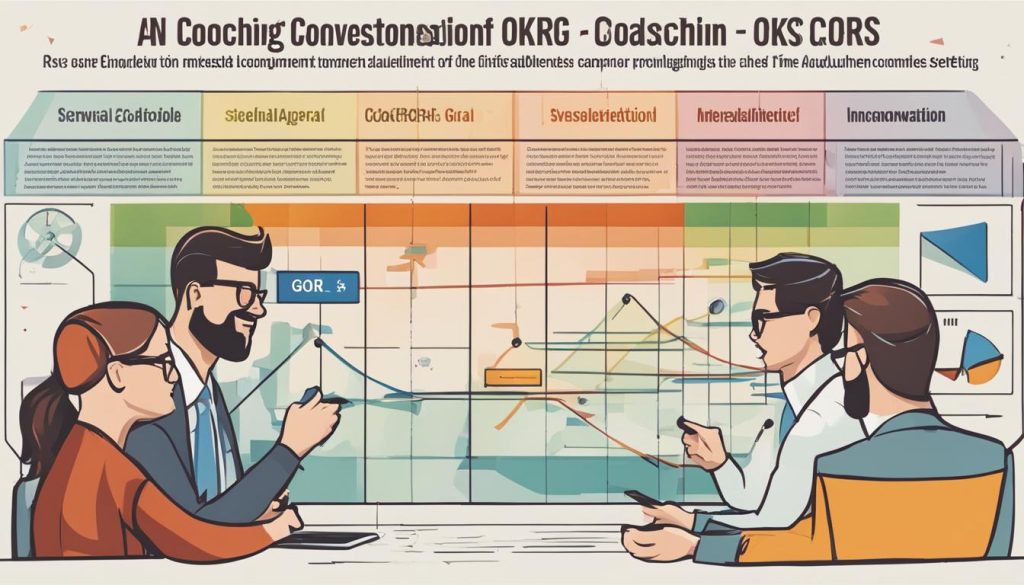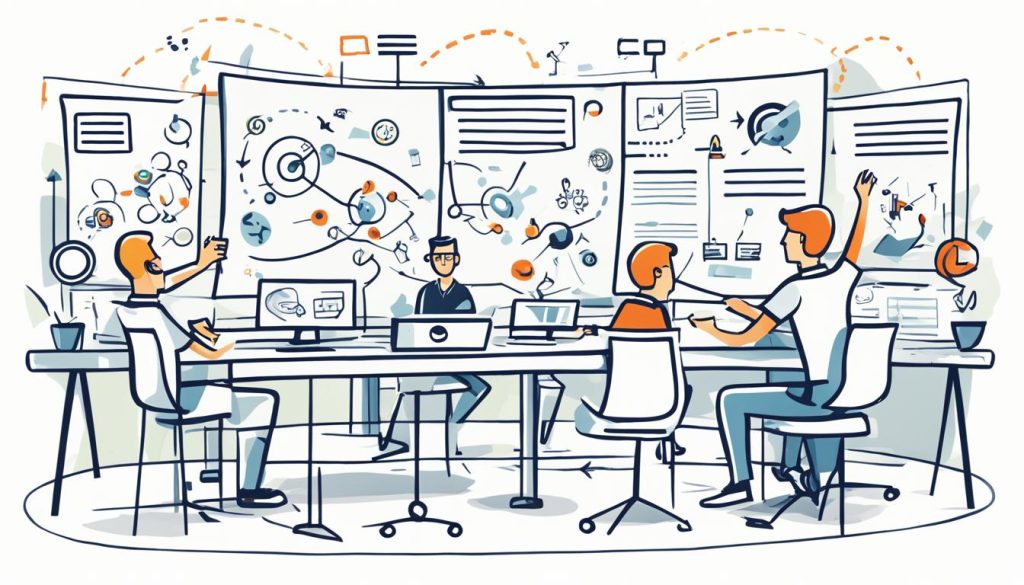Coaching conversations have evolved significantly in recent years, transforming the way organizations approach employee development and performance management. As a coach, I have witnessed the shift from traditional annual appraisals to more dynamic and employee-centric approaches that prioritize continuous feedback and coaching, goal alignment and OKRs, the embracing of technology, and a focus on employee well-being and engagement.
This evolution has not only enhanced coaching communication but also revolutionized the coaching conversation skills and techniques used today. By embracing these trends, organizations can create a culture of continuous learning, improve performance, and drive overall organizational success.
Key Takeaways:
- Coaching conversations have evolved from traditional annual appraisals to more dynamic and employee-centric approaches.
- Continuous feedback and coaching foster a culture of continuous learning and improvement.
- Goal alignment using OKRs promotes effective coaching communication.
- Technology integration enhances coaching dialogue and provides modern coaching techniques.
- Focus on employee well-being and engagement drives overall coaching effectiveness.
The Shift towards Continuous Feedback and Coaching
One of the most significant trends in coaching conversations is the shift towards continuous feedback and coaching. As organizations recognize the limitations of traditional annual or biannual performance reviews, they are adopting more frequent feedback mechanisms to drive employee development and performance improvement.
This trend enables employees to receive timely guidance, course corrections, and recognition, fostering a culture of continuous learning and improvement. With regular feedback, employees can make adjustments, address any challenges, and capitalize on their strengths in a timely manner.
This shift in coaching conversations has been facilitated by the impact of technology. Integrated platforms and software play a crucial role in providing a centralized space for real-time feedback and ongoing coaching conversations. These technological advancements have made it easier for managers and employees to communicate, collaborate, and provide feedback on a regular basis.
With technology, coaching conversations are no longer restricted to time-bound meetings or formal evaluations. They can happen in real-time, providing immediate feedback and guidance to employees. This instant feedback loop is particularly beneficial for skill development and performance enhancement.
Furthermore, technology allows for the recording and tracking of coaching conversations, ensuring that important insights and action plans are not lost. Employees can refer back to previous conversations and track their progress over time, making coaching more effective and impactful.
The shift towards continuous feedback and coaching has transformed the way organizations approach employee development. By leveraging technology, coaching conversations can be more timely, personalized, and impactful, leading to improved performance and employee engagement.
Overall, the impact of technology on coaching conversations has revolutionized the way organizations foster employee growth and development. With the ability to provide continuous feedback and coaching, organizations can create a culture of learning and improvement, resulting in enhanced performance and employee satisfaction.
| Benefits of Continuous Feedback and Coaching | Enhanced Performance | Improved Employee Satisfaction |
|---|---|---|
| Timely guidance and course corrections | Employees can make immediate improvements | Employees feel supported and valued |
| Recognition and reinforcement of positive behaviors | Motivates employees to continue performing well | Creates a positive work environment |
| Adaptability to changing business needs | Employees can quickly align their goals | Increased employee engagement and loyalty |
Goal Alignment and OKRs

In today’s evolving coaching dialogues, goal alignment has emerged as a powerful strategy for effective coaching communication. Organizations are leveraging the concept of Objectives and Key Results (OKRs) to connect top-level strategies with individual employee goals. This transparent and measurable framework ensures alignment of objectives at all levels, promoting collaborative coaching conversations and fostering a growth mindset.
By cascading organizational goals down to every employee, the implementation of OKRs has brought about evolutionary changes in coaching dialogues. Rather than focusing solely on performance evaluation, coaching conversations now emphasize aligning employee performance with strategic goals, thereby driving greater engagement and motivation.
“OKRs have revolutionized the way we approach coaching conversations. They provide a structure that aligns individual aspirations with broader organizational objectives, enabling more meaningful and effective coaching dialogues.”
– Jane Miller, HR Director at ACME Corp
In addition to promoting effective coaching communication, the use of OKRs encourages employees to take ownership of their goals and outcomes. It shifts the focus from a mere evaluation of performance to a continuous improvement mindset, fostering a culture of learning and development.
The implementation of goal alignment through OKRs has demonstrated its effectiveness in coaching conversations, enabling coaches to provide guidance and support that directly contributes to the attainment of strategic objectives. It creates a shared understanding of priorities and expectations, enhancing collaboration and driving performance improvement.
Overall, the integration of goal alignment and OKRs in coaching dialogues is a testament to the evolutionary changes in the coaching landscape. It demonstrates the shift from traditional performance management approaches to a more strategic and development-oriented mindset, laying the foundation for effective coaching communication and empowering employees to thrive in today’s dynamic business environment.
Embracing Technology for Enhanced Coaching Dialogue

The evolution of coaching conversations has paved the way for the integration of technology, enabling the adoption of modern coaching techniques and enhancing the overall coaching dialogue. The utilization of performance management software and integrated platforms has streamlined the coaching process by capturing real-time data and facilitating ongoing feedback. This integration not only saves time but also creates a more efficient and effective coaching experience.
The power of data analytics and artificial intelligence (AI) further amplifies the benefits of technology in coaching conversations. By leveraging performance data, organizations can derive valuable insights, make data-driven decisions, and identify patterns and trends that were previously unnoticed. The use of AI algorithms enhances the quality of feedback and recommendations, delivering more personalized and actionable guidance to individuals.
Table: Benefits of Embracing Technology in Coaching Conversations
| Benefits | Description |
|---|---|
| Streamlined Processes | Performance management software and integrated platforms automate administrative tasks, allowing coaches to focus more on the coaching dialogue and development. |
| Real-time Data Capture | The integration of technology enables the capture of real-time performance data, providing coaches with up-to-date information to support coaching conversations. |
| Ongoing Feedback | Coaching platforms offer a centralized space for continuous feedback, creating a feedback loop that promotes growth and improvement. |
| Personalized Guidance | Data analytics and AI algorithms generate insights to deliver tailored guidance, ensuring individualized coaching experiences. |
This integration of technology has transformed coaching dialogue by providing a centralized space for goal setting, progress tracking, performance conversations, and recognition. Coaches and employees can collaborate seamlessly, fostering effective communication and ultimately improving the overall effectiveness and impact of coaching conversations.
Conclusion
The evolution of coaching conversations has brought about significant transformations in the way organizations approach employee development and performance management. In this article, we have explored various trends that highlight the shift from traditional performance management practices to more employee-centric and agile approaches.
By embracing continuous feedback and coaching, goal alignment and OKRs, a development-focused mindset, technology integration, and a focus on employee well-being and engagement, organizations can not only transform coaching conversations but also drive overall organizational success. These evolutionary changes in coaching dialogues play a crucial role in enhancing coaching communication, fostering a culture of continuous improvement, and empowering employees to reach their full potential.
As coaching conversations continue to evolve, it is essential for organizations to keep up with the changing landscape and embrace these trends. By prioritizing transforming coaching conversations, organizations can create an environment that supports growth, development, and engagement, leading to increased employee satisfaction, productivity, and ultimately, business success in today’s rapidly evolving business landscape.
FAQ
How have coaching conversations evolved over the years?
Coaching conversations have undergone a significant evolution, with organizations moving away from traditional annual appraisals and embracing more dynamic and employee-centric approaches.
What are some of the trends in coaching conversations?
Some of the trends in coaching conversations include continuous feedback and coaching, goal alignment and OKRs, the shift from ratings to development, the embracing of technology, and a focus on employee well-being and engagement.
How does continuous feedback and coaching impact coaching conversations?
Continuous feedback and coaching enable employees to receive timely guidance, course corrections, and recognition, fostering a culture of continuous learning and improvement. This trend has been facilitated by the impact of technology on coaching conversations.
What role does goal alignment play in coaching conversations?
Goal alignment, particularly through the use of Objectives and Key Results (OKRs), helps align individual and team objectives with organizational priorities, promoting effective coaching communication and fostering a growth mindset.
How does technology enhance coaching dialogue?
Technology has revolutionized coaching conversations by providing modern coaching techniques and tools, such as performance management software and integrated platforms. These technologies streamline processes, capture real-time data, and facilitate ongoing feedback, improving overall coaching effectiveness.

